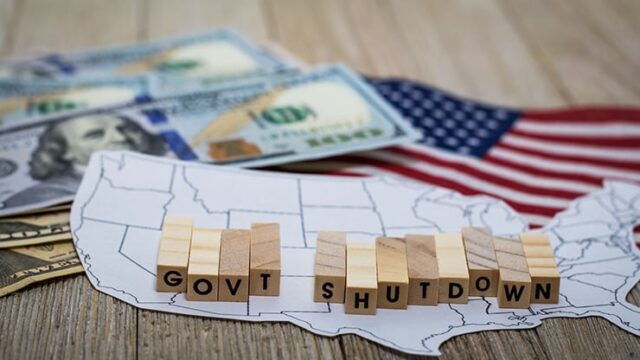The Charade of Federal Budgetary Showdowns

The United States government, unable to reach agreement on a budget for the new fiscal year, has been officially shuttered for well over a week. Americans no longer flinch at these showdowns and closures, as what used to be a frightening prospect for Americans has become commonplace. Sure, budgetary crises happened in “banana republics,” but they used to be unthinkable in America. People used to expect that the nation at the forefront of the free world and the issuer of the global reserve currency would have some greater degree of fiscal propriety and common sense than we are showing now.
Today, many Americans don’t appreciate that stalemates like these represent a profound crisis in our nation, both politically and financially, and the presumption is that the issue will resolve itself. We are comforted by equity markets that have shrugged their metaphorical shoulders, and remain near all-time highs, driven by what appears to be a bubble in Artificial Intelligence and related technology.
While much of the budgetary debate is shrouded in bureaucratic obscurity, the issues that divide the Republican and Democratic politicians are rooted in a familiar philosophic disagreement about the role of government and a less commonly understood dispute about the meaning of money.
The Democrats want to appeal to their voter base by extending entitlement benefits, especially healthcare and Medicaid. Many of these perquisites were augmented by the Biden administration during the COVID-19 era, when handouts were considered necessary to offset the effects of government-mandated lockdowns and business closures. But once an entitlement is given, it is very difficult (and politically dangerous) to retract it. Republicans want to curtail these benefits, and rescind some funding already appropriated for foreign aid and public broadcasting, but even then, they are only trimming around the edges. Both parties continue to ignore the elephant in the room, which is the raging federal deficit and the untenably high level of national debt, which foreshadows an inevitable monetary and financial crisis.
The antagonists are arguing over whether to spend somewhat more or a whole lot more, and on what. This is the wrong debate. It is like spouses bickering about how much and where to spend on home improvements, while neither of them seems to notice that their kitchen is on fire. There has been no real attempt to address the fiscal crisis, to end deficits and runaway spending, and to get the national debt under control.
If equity markets don’t seem to care, the bond markets do. They notice that the U.S. now has nearly $38 trillion of national debt, the equivalent of over $335,000 per taxpayer, and is running unsustainable deficits in the trillions of dollars each year. This has resulted in significantly higher borrowing costs for the U.S. government, which now pays well over a trillion dollars in debt service costs (i.e., interest) annually. Such astronomical amounts can only be funded by more debt, as federal revenue is insufficient. As a result, the independent credit ratings agencies have one by one downgraded the sovereign debt rating of the U.S., in part because grandstanding in Congress prevents members from doing anything effective to solve the problem.
In the meantime, much of the government has continued to function, as a number of services and programs are exempted from shutdowns. This has permitted, at least for the time being, the brinkmanship to continue on both sides. With payrolls for military and federal employees coming up later this month, however, things may change. History reveals that when armies don’t get paid, politicians wake up quickly.
It is a bit embarrassing as an American to watch this play out. We are roundly mocked by our adversaries, who would never permit such a thing to occur in China, Russia, or elsewhere. And they have a substantial point. We cannot borrow ourselves to prosperity while our national wealth dwindles.
Anticipating these events, I wrote at the start of the year to “expect gold to shine in 2025.” It certainly has, as reflected in prices. Gold has now topped $4000 per ounce, an all-time high, and an increase of 57 percent year-to-date. The rally in gold is not over. Analysts are expecting gold to go higher, with one investment bank raising their estimate by 15 percent and now projecting $4900 per ounce (22.5 percent higher) by year end 2026. I expected this, because of the continuing loss of faith in the financial stability of the U.S. government and thus the U.S. dollar, because of the accumulation of gold by dollar-skeptic central banks around the world, and the fact that more and more investors are waking up to the severity of the underlying fiscal problem.
Similarly, Bitcoin prices reached a new all-time high earlier this week of over $125,000, doubling in value from one year ago. Both gold and Bitcoin are seen as hedges against inflation and devaluation of the currency.
The budget stalemate will resolve, both sides will declare victory, and life will go on. But we are only kicking the proverbial can down the road. At some point we will come to a dead end. We will be confronted with a fiscal cliff, a moment when the U.S. government will have to choose whether to substantially raise taxes, cut expenses, and thereby reduce the debt.
Alternatively, the government will devalue the currency, allow inflation to run rampant, and keep the monetary printing presses running, even if that means using the Federal Reserve to buy U.S. debt at subsidized rates of interest. In this context, gold, BTC, and other hard assets seem a reasonable option for individual Americans trying to preserve wealth that is otherwise being eaten away by taxes, inflation, and increasing indebtedness.
https://chroniclesmagazine.org/web/the-charade-of-federal-budgetary-showdowns
